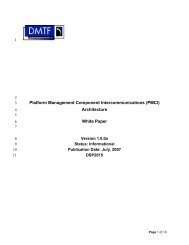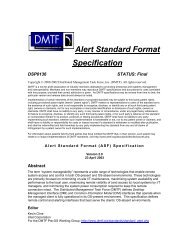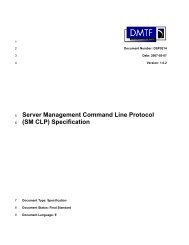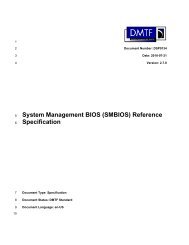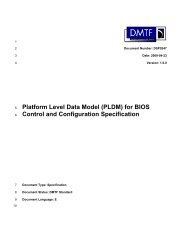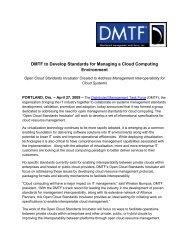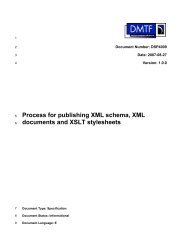Physical Platform Profiles Working Group - DMTF
Physical Platform Profiles Working Group - DMTF
Physical Platform Profiles Working Group - DMTF
Create successful ePaper yourself
Turn your PDF publications into a flip-book with our unique Google optimized e-Paper software.
13. Access to sensor data, including presence, temperature and other sensors.<br />
14. Access to logs – characterize, define content, retrieve and write<br />
15. View and set status indicators (LED, text LCD, alarms etc.)<br />
16. Configuration of service processors and their components/services.<br />
17. Media & KVM redirection<br />
18. Correlation of multiple Management Access Points (MAP)<br />
19. OS recovery assistance<br />
20. Access to security information, such as accounts, groups and security<br />
modules<br />
21. Network Interface monitoring and control including wired and wireless.<br />
22. IO interconnect technologies such as PCI, SMBus, Bluetooth, USB and other<br />
interconnects.<br />
By performing the following tasks:<br />
• Define an architectural model for Targeted <strong>Platform</strong> management<br />
• Leverage <strong>DMTF</strong> protocols and identify lightweight management stack(s)<br />
suitable for out-of-band management<br />
• Define platform independent, interoperable, industry standard management<br />
data models, profiles and registries for the aspects of managing the physical<br />
aspects of system platforms that are within the scope of the management<br />
solutions described above.<br />
• Define mechanisms for secure management<br />
• Define mechanisms for scalable management<br />
• Define mechanisms for scalable discovery & correlation<br />
The SDMPWG will also own the following tasks related to its area of focus:<br />
• Definition of the <strong>DMTF</strong> Management Initiative DASH<br />
• Definition of the <strong>DMTF</strong> Management Initiative SMASH<br />
• Work with the System Management Forum (SMF) to develop a compliance<br />
program for DASH & SMASH<br />
Examples of physical system platforms include, but are not limited to:<br />
• desktop platforms<br />
• mobile platforms<br />
• bladed PCs<br />
• Servers spanning the spectrum of:<br />
• Stand alone, blades, racks and partitionable systems<br />
• Enterprise & Telco<br />
• Low cost to mission critical<br />
In the course of authoring profiles, the WG will identify schema additions and<br />
modifications as necessary and work with the Schema Sub-Committee to incorporate<br />
these changes.<br />
The focus of the WG is management of Targeted <strong>Platform</strong>s for in-band, out-of-band, inservice,<br />
and out-of-service (consistent with definitions in DSP2001) environments. This<br />
includes interactions with the operating system that are necessary to assist in<br />
hardware management. Direct management of a running operating system and its<br />
associated applications is out of scope.<br />
The Server, Desktop, Mobile <strong>Platform</strong>s WG reports to the <strong>Platform</strong> Management<br />
Subcommittee.<br />
Alliance Partnerships<br />
• SNIA (Storage Networking Industry Alliance: Storage Management Initiative)<br />
Server, Desktop, Mobile <strong>Platform</strong> WG Charter Page 2 of 4



